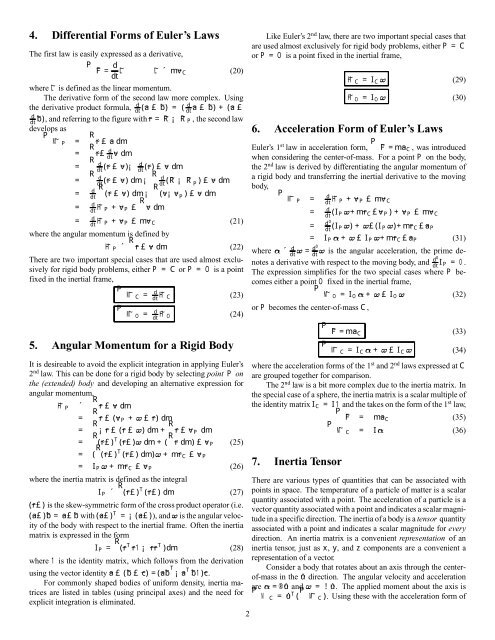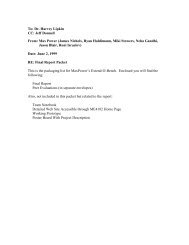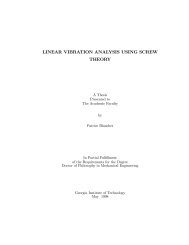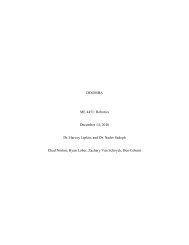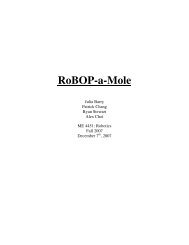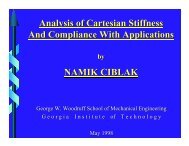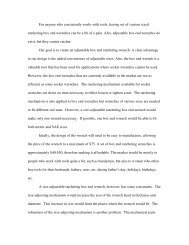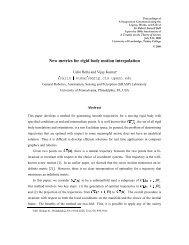Euler's Dynamic Equations - Theory - helix
Euler's Dynamic Equations - Theory - helix
Euler's Dynamic Equations - Theory - helix
Create successful ePaper yourself
Turn your PDF publications into a flip-book with our unique Google optimized e-Paper software.
4. Differential Forms of Euler’s LawsThe first law is easily expressed as a derivative,P ~F=ddt ~ L ~ L´m~vC (20)where ~L is defined as the linear momentum.The derivative form of the second law more complex. Usingthe derivative product formula,ddt (~a£~ b)= ( d dt ~a£~ b)+(~a£ddt ~ b), and referring to the figure with~r= ~ R¡ ~ R P , the second lawdevelops asP ~ M P= R ~r£~adm= R ~r£ d dt ~vdm= R ddt (~r£~v)¡ d dt (~r)£~vdm= R d(~r£~v)dm¡R ddt (~ R¡ R ~ P)£~vdmR=dtR d (~r£~v)dm¡ (~v¡~vP )£~vdm= d dt ~ H P +~v P £ R ~vdm= d dt ~ H P +~v P £m~v C (21)where the angular momentum is defined by~H P ´R~r£~vdm(22)There are two important special cases that are used almost exclusivelyfor rigid body problems, eitherP =C orP = O is a pointfixed in the inertial frame,P ~ MC = d dt ~ H C (23)P ~ M O = d dt ~ H O (24)Like Euler’s 2 nd law, there are two important special cases thatare used almost exclusively for rigid body problems, eitherP =CorP =O is a point fixed in the inertial frame,~H C =I C ~! (29)~H O =I O ~! (30)6. Acceleration Form of Euler’s LawsEuler’s 1 st law in acceleration form, P F=m~aC ~ , was introducedwhen considering the center-of-mass. For a point P on the body,the 2 nd law is derived by differentiating the angular momentum ofa rigid body and transferring the inertial derivative to the movingbody,PMP ~ = d ~ dtH P +~v P £m~v C= d dt (I P~!+m~r C £~v P )+~v P £m~v C= d0dt (I P~!)+ ~!£(I P ~!)+m~r C £~a P= I P ~®+ ~!£I P ~!+m~r C £~a P (31)where ~®´d ~! =d0~! is the angular acceleration, the prime denotesa derivative with respect to the moving body, and d0dt I P =0.dt dtThe expression simplifies for the two special cases where P becomeseither a pointO fixed in the inertial frame,PM ~ O =I O ~®+ ~!£I O ~! (32)orP becomes the center-of-mass C,P ~ F=m~a C (33)5. Angular Momentum for a Rigid BodyIt is desireable to avoid the explicit integration in applying Euler’s2 nd law. This can be done for a rigid body by selecting point P onthe (extended) body and developing an alternative expression forangular momentum,~H P ´ R~r£~vdm= R ~r£(~v P +~!£~r)dm= R ¡~r£(~r£~!)dm+ R ~r£~v P dm= R (~r£) T (~r£)~! dm+( R ~rdm)£~v P (25)P ~ MC =I C ~®+ ~!£I C ~! (34)where the acceleration forms of the 1 st and 2 nd laws expressed atCare grouped together for comparison.The 2 nd law is a bit more complex due to the inertia matrix. Inthe special case of a sphere, the inertia matrix is a scalar multiple ofthe identity matrixI C =I1 and the takes on the form of the 1 st law,P ~ F = m~a C (35)P ~ MC = I~® (36)= ( R (~r£) T (~r£)dm)~!+m~r C £~v P= I P ~!+m~r C £~v P (26)where the inertia matrix is defined as the integralI P ´R(~r£) T (~r£)dm (27)(~r£)is the skew-symmetric form of the cross product operator (i.e.(~a£) ~ b=~a£ ~ bwith(~a£) T =¡(~a£ ), and~! is the angular velocityof the body with respect to the inertial frame. Often the inertiamatrix is expressed in the formI P = R (~r T ~r1¡~r~r T )dm (28)where1 is the identity matrix, which follows from the derivationusing the vector identity~a£( ~ b£~c)=(~a ~ b T ¡~a T ~ b1)~c.For commonly shaped bodies of uniform density, inertia matricesare listed in tables (using principal axes) and the need forexplicit integration is eliminated.27. Inertia TensorThere are various types of quantities that can be associated withpoints in space. The temperature of a particle of matter is a scalarquantity associated with a point. The acceleration of a particle is avector quantity associated with a point and indicates a scalar magnitudeina specific direction. The inertia of a body is a tensor quantityassociated with a point and indicates a scalar magnitude for everydirection. An inertia matrix is a convenient representation of aninertia tensor, just as x, y, and z components are a convenient arepresentation of a vector.Consider a body that rotates about an axis through the centerof-massin the ^u direction. The angular velocity and accelerationareP~®=®^u and ~! = !^u. The applied moment about the axis isM C =^u T ( P MC ~ ). Using these with the acceleration form of


